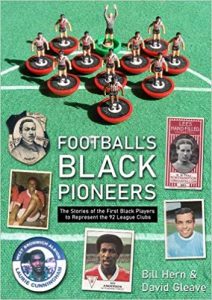Book Review: Football’s Black Pioneers: The Stories of the First Black Players to Represent the 92 League Clubs by Bill Hearn & David Gleave
 2020 will undoubtedly be remembered as the year that the world was brought to a standstill by the COVID-19 outbreak, but it also will be remembered for the Black Lives Matter campaign that also went global, sparked by the killing of George Floyd in the USA whilst being arrested by a white police officer. Given that scenario, the release of Football’s Black Pioneers: The Stories of the First Black Players to Represent the 92 League Clubs by Bill Hearn and David Gleave is timely indeed.
2020 will undoubtedly be remembered as the year that the world was brought to a standstill by the COVID-19 outbreak, but it also will be remembered for the Black Lives Matter campaign that also went global, sparked by the killing of George Floyd in the USA whilst being arrested by a white police officer. Given that scenario, the release of Football’s Black Pioneers: The Stories of the First Black Players to Represent the 92 League Clubs by Bill Hearn and David Gleave is timely indeed.
The two authors have taken the 92 clubs of the top four divisions of the English game and through their research discovered the first black players that pulled on the shirt for those teams. For some clubs it throws up some interesting results, take Leeds United for example. Many of the Elland Road faithful would presume that the talented Albert Johanneson was the first black player to represent the club, whereas in fact that honour belongs to Gerry Francis who debuted on 30 November 1957 against Birmingham City. As a Fulham fan, I had seen Stan Horne play in the early 1970s and was reliably informed that he was the Cottagers first black player. However, this book provides evidence that Egyptian player Hassan Hegazi turned out for the club in November 1911.
Indeed this book is littered with great surprises and stories at every turn, so readers get to learn about the black pioneers of the Victorian era such as Arthur Wharton, Fred Corbett and John Walker all the way through to those players of the ‘new-boys’ in the Football League such as Salford City and Harrogate Town. A personal favourite is the Stevenage chapter, which tells the story of Roland Butcher the first black player to play Test Cricket for England and who turned out for the football club in the early 1970s – talented indeed. In addition there are many familiar names including Howard Gayle, Viv Anderson, Laurie Cunningham and Chris Kamara, but also many others who made only a handful of appearances in becoming forerunners and ground breakers for the black players in the modern game.
Whilst the book is enormously entertaining it also details the issues that players and their families suffered both on and off the pitch. The discrimination is laid bare as stories of the abuse suffered by being a minority in cities up and down the country are told, as with the struggle to find accommodation and work especially for the Windrush generation. On the pitch, black players suffered racist chanting, being spat at, having bananas thrown at them and discriminatory behaviour from within their own club. One telling aspect as to how times have changed from the book, is that many players of the 1970s recount how they were told or indeed simply put up with the racism from the terraces and their opponents. However, this is not a position shared by players subsequently and we have seen in recent years, games being halted and in some cases abandoned due to racism whether from the stands or the opposition.
This is an excellent piece of research and writing, which is both informative in relation to the experiences of black players down the years and their contribution to football in England, but an insight into the game and social history over that period. Football has come some way in throwing off its racist images from the dark days of the 1970s and 80s, but there should be no room for complacency and as recent events have shown there is still work to be done.
(Conker Editions Ltd. August 2020. Paperback 228 pages)